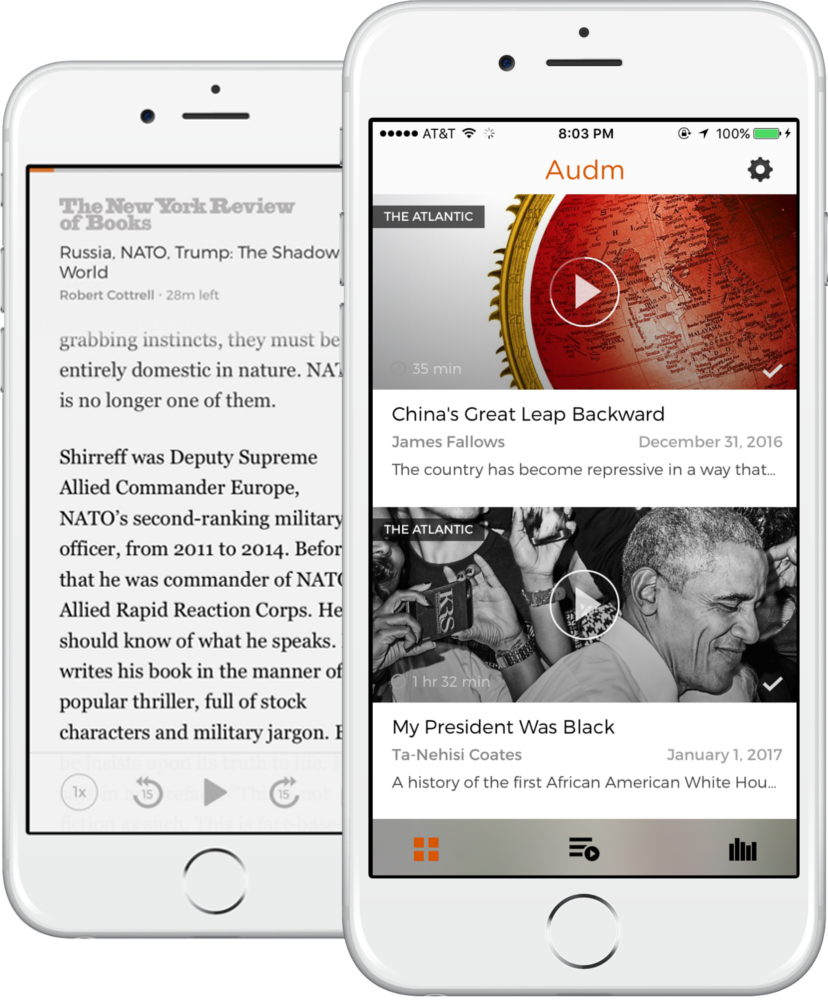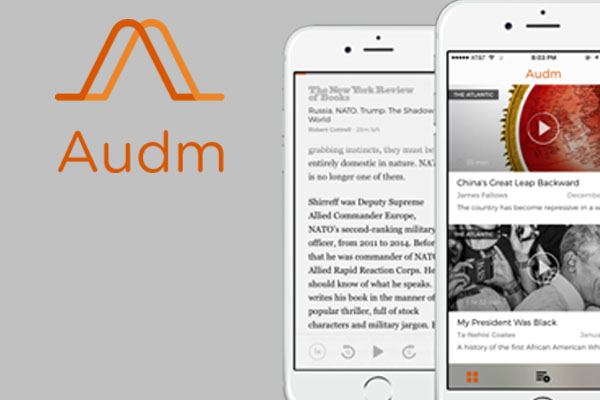Voicebot Interview with Audm’s Christian Brink – Providing High Quality Written Content as Rich Audio
 Christian Brink is the co-founder of Audm which bills itself on Twitter as, “The best long form stories, read aloud.” The mobile app and soon-to-be Alexa skill are all about transforming high quality, information dense written material into a rich audio format. Publishers using Audm include The Atlantic, New York Review of Books, Outside Magazine, Propublica and Foreign Policy. You can try the iOS app here.
Christian Brink is the co-founder of Audm which bills itself on Twitter as, “The best long form stories, read aloud.” The mobile app and soon-to-be Alexa skill are all about transforming high quality, information dense written material into a rich audio format. Publishers using Audm include The Atlantic, New York Review of Books, Outside Magazine, Propublica and Foreign Policy. You can try the iOS app here.
Tell me about Audm. What do you do?
Christian Brink: We are a destination platform from the publication’s point of view for creating an audio experience of your best long-form journalism. From a consumer standpoint, it’s the best place to get your long-form content, or narrative journalism in one place. In a lot of ways, it is comparable to podcasts, but it is to podcasts what the Sopranos is to reality TV. The best storytellers are typically not writing for podcasts.
Your product is an audio listening app and you also do the written content conversion to audio. Is that correct?
Brink: Yes. If you have a piece of content that is dense in information, it is necessary to treat it differently when converting to audio. We are both the packaging and the destination for long-form journalism [converted to audio].
Do you ever need to alter the written text to make it more easily consumed in an audio format?
Brink: In some very particular instances we do. An article we did from the London Review of Books about Bitcoin and monetary policy is a good example. For a segment of the article that described what Bitcoin did, the text version displayed some 64 character strings. It’s hashed data. They displayed the 64 character strings to show people that it doesn’t look like a ledger. In the audio it would have been awkward. We wrote a replacement paragraph that described the strings.

One of the 64 character strings from the London Review of Books article.
That is something we did only with consultation with the editorial team and the author. It is a little weird to read the 64 character strings out loud. It has to be a pretty clear cut case like that in order to rewrite content. We relish having complex grammar narrated really well by narrators that understand how to speak complex composition. That is a point of pride for us.
Why did you start Audm?
Brink: We are doing this because we love the content and are excited it is becoming available in audio form. We are treating the content well and providing it with a great audio format.
In addition to this, we are staying a step ahead of the voice computing wave which is moving quickly. Access to digital audio content is going to follow you around throughout the day. Whether in your kitchen, car or office, access is going to become ubiquitous and grow in terms of time spent.
We are doing justice to long-form content with great audio design and production. Also, we are leading the development in the formats on the frontier of voice computing by adding interactivity.
Tell me about how you are adding interactivity.
Brink: Some of the current content will change from static to interactive. You may not do this with music, because most of us aren’t musicians. But it makes a difference with other content. An example of interactivity that transforms what we have traditionally referred to as static content is when you come back to a story after three days and don’t remember a character’s background. You can ask, “Alexa, who is Alice?” Alexa then comes back and tells you something about the character and how they fit into the story. [Editors note: This would have been really helpful reading Dostoevsky].
Are you developing technology to support interactivity?
Brink: We are not ready to make any announcements today, but it is the backbone of our roadmap for the rest of 2017 and on into 2018. We are working to make spoken word audio content more interactive.
What are you doing with voice interactivity in the near term?
Brink: There are three things. First, basic voice control for the voice app. So, if someone is blind or visually impaired they can use the app. We haven’t done nearly as well as we can thus far, but we have many people in the accessibility community suggesting features to add to our iOS app.
Next, we want to get an Alexa skill deployed that will throw the experience from your phone to an Echo device. Then we want to further integrate that into browser plugins for publisher websites so you can continue listening to an article you started reading. Transitioning seamlessly between devices is a big opportunity. We expect to have the Alexa skill out within two months.
We are also enriching static content with metadata so people can pause a story and ask questions about what they are listening to. This is not encyclopedic knowledge such as, “How high is Mount Everest?” It is something about the story they are listening to such as, “How did Chris and Gracie meet?”
 Spoken Layer and others have provided voice recordings that companies can use in their apps. You have your own app. Why is that a better strategy?
Spoken Layer and others have provided voice recordings that companies can use in their apps. You have your own app. Why is that a better strategy?
Brink: A central fact about our business is that we are a consumer brand representing a destination that people can rely on to get the best content in the category of long-form feature journalism that is produced to the quality appropriate for content that is so dense in information. What we are doing with audio production is something that we are proud of, but it isn’t central to what we are trying to be. Selling content production to publishers is a good business, but that is not our business.
The reason we are doing is because our business is different. We need super premium production value. This type of audio isn’t being produced by anyone right now so we are doing it. If someone else steps in and the quality is good enough to do justice to the content, we will use them. Audm is a destination for the consumer to get this content.
How is Audm different from 60db?
Brink: The difference between 60db and Audm is the content, the format choices and the source of the content. Some of their content is previously recorded audio taken from video. They are also producing their own content directly with journalists to create audio that is 5-10 minutes long.
There is a difference in terms of how they want you to consume their content. It is more like radio. It is written and produced for audio first. The information destiny for material that is written originally for audio is much less than written material. There is a place in the market for the most information dense audio content. Audm is about maximum information density. That is our focus.
Tell me about your partnership with Witlingo?
Brink: We are Witlingo’s preferred partner for helping publications and content owners figure out out a strategy for getting their text content into audio form. Witlingo is our preferred partner for getting Alexa skills built and developing a voice UI for getting into voice computing.
We are also collaborating on an Alexa skill. We have our own developer talent, but they have been helpful particularly in thinking through the design side of it. They have been invaluable.
What is your favorite Alexa skill?
Brink: The one that I use the most is Spotify. My wife and I use it in the kitchen in the morning. Part of our way of waking up is unexpectedly having Alexa play songs through Spotify.









